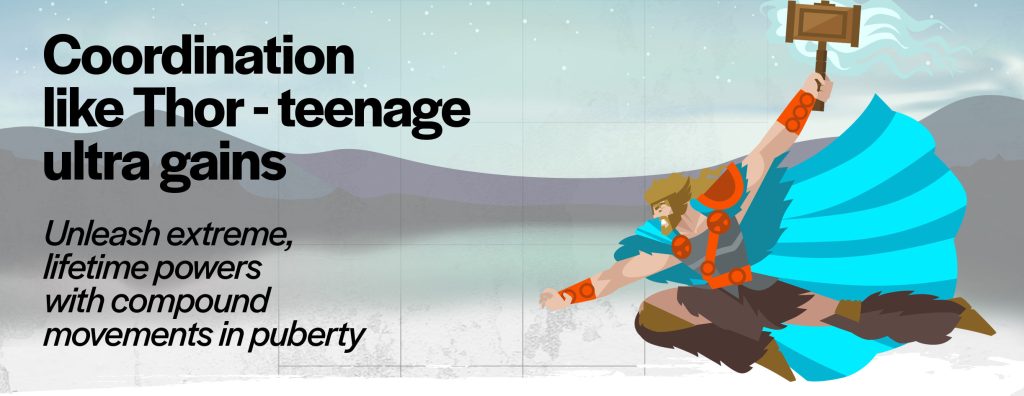During puberty you can hitch a ride to max out on sports coordination for life. It’s a unique opportunity you don’t want to miss, and I’ll explain the physiological science here. My pro tip is to engage in different disciplines and sports from the age of ten onwards, if not earlier.
I don’t mean random participation depending on your mood, but properly learn and master the main concepts and motions that the varying disciplines can offer. Over time you will make your choice of preference, but don’t specialise too early, it prevents your brain from maxing out its potential.******
Muscle coordination – the science
You aren’t heeding the flow of your blood or the scratch on your knee being repaired or all the other work your body is doing in the background. But you think you are in full charge of your skeletal muscles.
Not true: We are in control of our movements, but not of our muscles. You command your body to perform a jump, which is the outcome, but you don’t consciously activate and regulate the about 75 (!) muscles necessary to do it.
The main “big” brain delegates all the movement functions to its subordinate, called the cerebellum. This is your mainframe of movement: the cerebellum plans movements and motor learning. It also receives information from the proprioceptors throughout your body to process spatial data in real time, allowing for errors and change of external conditions. Plus, it collects the information from eyes, ears and the balance sensors via the main brain to perfect actions and movements.*
All these signals are constantly transmitted through power lines called motor nerves. Motor nerves can be simplified as cables that send the command down the line towards muscles, which in turn contract to initiate the motion. That ball you want to catch!
Sensory nerves help out too. They report back with a tonne of data to help adjust – tactile, smell, pain, and a more complex set of data – proprioception (= nervous system’s ability to respond to spatial awareness).**
Each main nerve then branches out into smaller and smaller nerves, each innervating a relatively small number of fibres within the muscle (hyperlink youth muscle blog). This allows us to meticulously fine tune the motion in terms of force generated, time of contraction, energy expenditure, velocity, etc.*** In nanoseconds!
Perfecting your coordination
There are more than 650 skeletal muscles, there are different bundles of fibres within each muscle, there are nerves and there’s brain control – we can understand how many elements need to work harmoniously together with ultra-precise timing to achieve a jump! Coordination is the organisation of all that.
Delving deeper, there are two main kinds of coordination: intramuscular and intermuscular:
Intramuscular coordination lets your nervous system activate as many fibres within the same muscle simultaneously in order to maximise the power output. Once again, think about one single jump, the highest you can do. One of the reasons why you jump higher and higher over time is because your cerebellum learned how to synchronise all your muscle fibres at once. Not because your fibres are stronger or bigger, or that there are more of them. Nothing changed in the muscle, apart from the ability of its tiny components to work precisely and once!****
Intermuscular coordination is more complex. It is the combination of muscles used and the order and proportion in which they are fired up by the brain to chip in. It is basically your skills. It is not only a neuro-physiological trait but also something you have to learn, repeat and perfect over time. For example a 3 pointer shoot or a layup in basketball.****
How do we develop coordination?
For intramuscular coordination, power movements are essential. To force the synchronisation and override our natural “default setting” of energy saving, we need to work with movements that generate a lot of force in a short time, AKA power (force x speed = power). It is relatively “easy” to program a power session in a gym or on a track, but the catch is that you need time beforehand to master the right movements safely and effectively before expressing your real potential. Some examples are plyometric jumps, sprints, Olympic lifting, and some kettlebell exercises.*****
Intermuscular coordination is our ability to perform complex tasks. Teenage brains are fully grown in size and density. But you have one shot during puberty to hardwire sports skills for life! This is the time where most of your neural connections are formed, making the brain capable of complex reasoning and remaining plastic at the same time. You can learn complex tasks, like BMX crankflips, 180 degrees jumps with a snowboard, handstand walk or a somersault! Better still: it will stick with you for pretty much the rest of your life, hard-wired in your brain during its development years. ****
References
*Zajac F. E. (1993) ‘Muscle coordination of movement: a perspective’. Journal of Biomechanics, 26(1), 109-124.
**Hug F., Tucker K. (2017) ‘Muscle Coordination and the Development of Musculoskeletal Disorders’. Exercise and sport science reviews, ACSM, 45(4), 201-208.
***Hug F., Tucker K. (2017) ‘Muscle Coordination and the Development of Musculoskeletal Disorders’. Exercise and sport science reviews, ACSM, 45(4), 201-208.
****Illarionova A.V., Kapilevich L.V. (2014) ‘Distinctive features of intramuscular and intermuscular coordination at power graduation in context of balance training’. National research Tomsk state university.
*****Carson G.(2006) ‘Changes in muscle coordination with training’. Journal of applied physiology, 101, 1506-1513.
******Kanwaii J. S., Jung Y. J., Zhang (2016) ‘Brain Plasticity during adolescence: effect of stress, sleep, sex and sounds on decision making.’ Journal of Anatomy and Physiology: current research, 6(1).
*******Vernooij C. A., Rao G., Perdikis D., Huys R., Jirsa V. K., Temprado J. (2016) ‘Functional coordination of muscles underlying changes in behavioural dynamics’. OPEN Scientific reports.
Further reading
Trevarthen, C. (1986) ‘Development of Intersubjective Motor Control in Infants’. NATO scientific Affairs Division.
Budde, H., Wegner M., Soya H., Voelcker-Rehage C., McMorris T. (2016) ‘Neuroscience of Exercise: Neuroplasticity and Its Behavioral Consequences’. Hindawi Publishing Corporation, 2016, 1-3.





